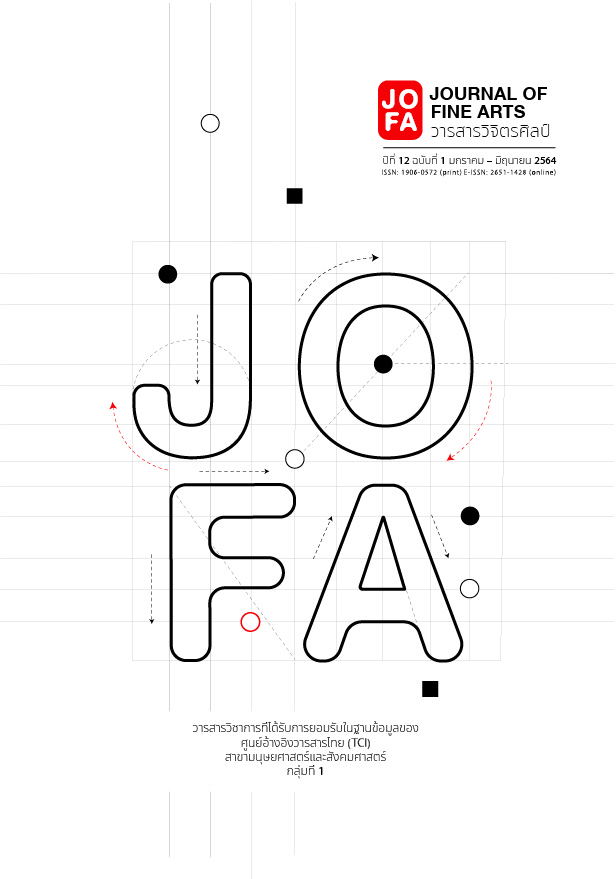The Goddess Of Rice: A Meaningful Artwork For Will And Hope Of Thai Agriculturists
Main Article Content
Abstract
Phra Mae Phosop, or the Rice Goddess, is the guardian deity of rice plants with the special features of beauty and mercy. In the field of art, Phra Mae Phosop presented in the form of paintings and sculptures suitable in the period of time they were created. However, painted idols and sculptures of faith had forms with little aesthetic beauty because the craftsmen did not study sculpture. They only inherited styles and methods that had been duplicated repeatedly. The researcher conducted research on Phra Mae Phosop, and then incorporated the findings into the creation of contemporary paintings and sculpture and still maintain the beauty and faith.
The researcher has collected information from a total of 12 samples of art work of Phra Mae Phosop, in order to analyze them according to artistic principles. Six of the samples are paintings and six are sculptures. It can be concluded from the research that the pattern according to the iconography of Phra Mae Phosop is a supreme goddess. She is depicted as a beautiful woman dressed in garments and accessories suitable in that period of time. Her most notable feature is one hand holding ears of rice. The researcher analyzed the
prominent features according to the iconography, appearance, structure, lines, colors, patterns, and ornament decorations.
Lastly, the researcher extracted new knowledge to be used for creating art of faith of Phra Mae Phosop.into 1 flow chart and 8 principles: 1) The plump body shape conveys the abundance of agricultural products. 2) Structure the body into a triangular shape to convey peace and faithfulness. 3) Standing and sitting postures shows dignity, resembling gods that have special abilities.4) Holding ears of grain or a sickle conveys agricultural abundance. 5) Apparel and accessories resemble noblewomen or aristocrats. 6) Toplessness follows the principles of Hindu deities’ iconography.7) The body shape shows sweetness, suaveness, and admirability. 8) Sitting on a creature or throne conveys nobility. Finally, the art works created from the application of the research findings were exhibited at the Phosopparnchalee Exhibition. They were installed at two places, namely, the Aditayathorn Agriculture Project in Surin Province and the Farmer’s school of Rai Cherntawan International Introspection Center in Chiang Rai province.
Article Details
References
Kosad, S. “Mǣphōsop. [Mae Phosop]”. Silpakorn University Journal 3, No.1 (June 1949), 80.
Nātchamnong, T. Watthanatham khāo Thai. [Thai Rice Cuture]. Bangkok: Chonniyom. 2016.
Pengkaew, N. “Mǣphōsop mī mā tǣ mư̄adai” [The Biginning of Pha Mae Phosop]. Muang Boran Journal 42, no. 3 (2016), 158 - 159.
Satsanguan, N. “Watthanatham khāo nai sangkhom Thai: kān khong yū læ kān plīanplǣng. [Rice Culture in Thai: Persistence and Change]. ” Bangkok: Faculty of Political Science, Chulalongkorn University, 2002.
Sujachaya, S. Watthanatham khāokhō̜ng Khon Thai lumnam nakhō̜n chai sri. [Thai Rice Culture in Nakornchaisri Canal]. Mǣphōsop Sālī Thēwa Nārī Ton Khāo. [Mae Phosop The goddess of Rice]. Faculty of Liberal Arts. Bangkok: Mahidol University, 2018.
Thongdee, I. khāo : watthanatham læ kān plīanplǣng. [Rice: Culture and Change]. Bangkok: Matichon,1995.
Yoo-in, N. Kān damrong khwām chư̄a læ phithīkam kīeokap khāo nai sangkhom Thaipatčhuban: kō̜ranī sưksā mūbān dō̜n phō tambon chāi nā ʻamphœ̄ sēnā čhangwat Phra Nakhō̜n Sī ʻAyutthaya. [Persistence of beliefs and rituals concerning rice in contemporary Thai society: a case study of Don Pho Village, Tambon Chaina, Amphoe Sena, Changwat Phra Nakhon Si Ayutthaya]. Research report, Faculty of Arts, Chulalongkorn University, 2010.


